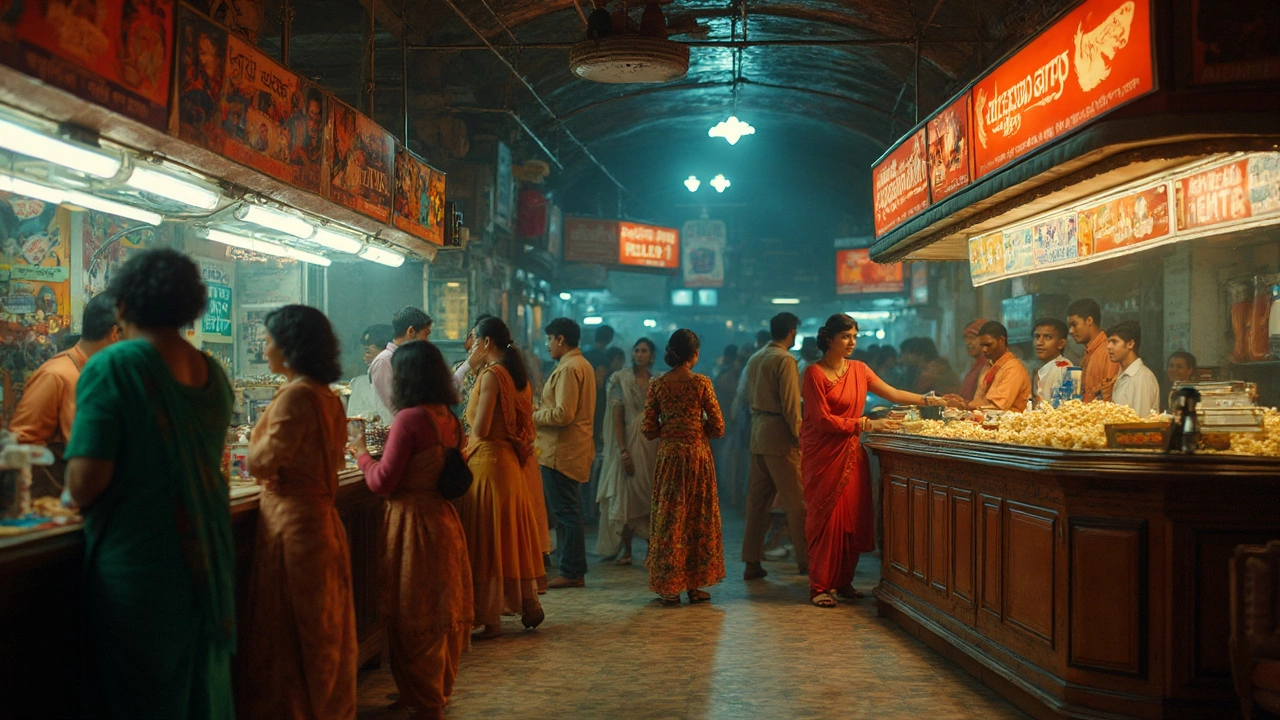How Much Money Do Theatre Owners Make in India?
 May, 20 2025
May, 20 2025
You’d be surprised how many people think theatre owners in India are rolling in cash just because a movie ticket costs more than a fancy burger in some cities. But here’s the thing—making money from a theatre is way tougher than it looks.
If you’re hoping to set up a cinema or just curious about this side of the entertainment world, it helps to understand where theatre owners actually make (and lose) money. Ticket sales, popcorn, ads, and even that cup of chai contribute to the bottom line, but the real profit comes from a combination of smart choices and hard bargains with distributors.
Setting up a theatre isn’t just about putting up a screen and some seats. There are license fees, heavy monthly electricity bills, payments to film distributors, and wages for a team that’s always on its toes, not to mention property rent or loans. Each of these things can shrink what’s left in the owner’s pocket—sometimes by a lot.
If you ever wondered how much a theatre actually earns in a city like Mumbai or a small town in Uttar Pradesh, the answers will probably surprise you. Let's break this down, get real with the numbers, and see what you’d actually face if you ran a cinema in India today.
- Where the Money Really Comes From
- Big Costs That Eat Into Profits
- How Much Do Owners Take Home?
- Multiplex vs. Single-Screen: The Earning Gap
- Tips to Make Theatre Business Work
Where the Money Really Comes From
The biggest misconception out there? That theatre owners make money only from ticket sales. Reality is, that’s just one slice of the pie—in some cases, not even the biggest one. In India, cinema owners pull in money from four main sources: tickets, food and drinks (concessions), advertising, and renting out the space for events or private screenings.
Here’s a quick breakdown of what actually brings in the cash:
- Ticket Sales: These are usually the most visible income source, but around half goes straight back to the film producers and distributors. Opening week? Theatre keeps just 40–50% of ticket sales. By the third or fourth week, the share can jump to 60–70% as box office collections shrink, but the audience is smaller too.
- Concessions: Popcorn, samosas, tea, and those ever-expensive cold drinks—these are huge. Many theatre owners say food sales actually rake in more margin than tickets, sometimes up to 80% of the price is pure profit.
- Advertising: Before the film starts and even on-screen during breaks, local and national brands pay good money for ads. A big cinema in a metro can earn ₹5–10 lakh a month just from ad spots.
- Private Rentals: School events, birthday parties, and corporate gatherings use cinema halls during off-peak times. This revenue is smaller but steady for many standalone theatres.
Don’t just take my word for it. Saurabh Varma, CEO of INOX Leisure, once said:
“Concession sales and advertising are our lifeline. They make up nearly half of our income, with tickets forming the remainder.”
Here’s a snapshot of how a typical theatre owner's monthly revenue might look in an average Indian city multiplex (in rupees):
| Source | Average % of Revenue | Estimated Monthly Value |
|---|---|---|
| Ticket Sales | 50% | ₹15,00,000 |
| Concessions | 35% | ₹10,50,000 |
| Advertising | 10% | ₹3,00,000 |
| Private Rentals | 5% | ₹1,50,000 |
Multiplexes in big cities obviously make more, but even small-town single screens depend on the combo of tickets and samosas to survive.
Bottom line? If you’re thinking of starting a theatre, you can’t just bank on movies bringing the crowd. You’ve got to work every angle—from snacks to ad deals—to really see the money roll in.
Big Costs That Eat Into Profits
Running a cinema in India sounds glamorous, but the bills hit hard every single month. Let’s break down the real expenses that most theatre owners have to deal with — these aren’t small numbers, and they cut straight into the profit.
First off, rent is one of the biggest headaches. Prime locations in cities like Bengaluru or Mumbai can eat up lakhs every month, and even in small towns, a decent property doesn’t come cheap. If you buy the property, there’s a hefty loan and EMIs to worry about.
Then there’s electricity. Running those big digital projectors, air conditioners, bright lobby lights, and sound systems means jaw-dropping power bills. It’s common for a single-screen to pay ₹1-2 lakhs a month. Multiplexes can pay way more, especially in the summer.
Movies aren’t free for owners, either. Distributors take a massive slice of the ticket sales. For a new Bollywood release, the distributor’s share usually takes away 50–55% of gross ticket revenue in the first week, and can still take 40% or more even later. For Hollywood movies, it leans even higher sometimes. That leaves theatre owners with much less than you’d expect from ticket sales.
Wages also stack up fast. Whether it's the people at the box office, ushers, cleaners, projectionists, or the guy pouring Pepsi, you need a decently sized team running over multiple shifts, 7 days a week. Even in 2025, you can count on spending ₹60,000 to ₹2 lakh per month on staffing, depending on your city and setup size.
Licenses and annual maintenance are another drain. You need at least half-a-dozen permissions covering safety, health, public performance, and more. Just renewing these can cost from ₹1 lakh to over ₹5 lakhs a year, not to mention regular repairs for projectors, sound, AC, and seats. Tech upgrades hit hard, especially as viewers expect the latest experience.
And let’s not forget GST—current rates for tickets above ₹100 are at 18%. This gets cut before the owner even sees the money. Then, there are extra city or state-specific taxes piled on in some regions. It adds up fast and slices margins thin.
Some owners try to balance these costs through food and beverage, where the margins are higher. But stocking up the snack counters needs upfront cash too—supplies, branded soft drinks, and the new rage of gourmet popcorn lines.
If you’re looking at the bottom line, these running costs and payouts leave much less profit than outsiders guess. The real money isn’t what’s printed on the ticket; it’s what’s left after everyone else gets their cut.

How Much Do Owners Take Home?
If you’re thinking theatre owners pocket all the ticket sales, you’re in for a shock. The money gets split so many ways before it lands in their bank account. The biggest chunk—sometimes over 50%—goes straight to film distributors. Owners only get their piece after that, and it shrinks with every week a movie runs.
Let’s look at some real numbers. A single-screen theatre in a Tier-2 city (think Indore or Kochi) usually earns between ₹4,00,000 and ₹10,00,000 a month from all sources. But actual earnings are way less after expenses. After paying salaries, electricity, licenses, and distributor fees, typical net profit ranges from ₹50,000 to ₹2,00,000 monthly. Multiplexes in big cities can clear higher numbers—but their costs are sky-high too. Data from a FICCI-EY 2024 report showed an average multiplex profit around ₹3,00,000–₹10,00,000 a month, but only when movies perform well and seats are consistently filled.
Here’s a quick look at an average single-screen’s monthly financials (in INR):
| Revenue Source | Monthly Income |
|---|---|
| Ticket Sales | ₹6,00,000 |
| Food & Beverages | ₹1,50,000 |
| On-Screen Ads | ₹50,000 |
| Total Revenue | ₹8,00,000 |
| Monthly Expense | Amount |
|---|---|
| Distributor Share | ₹3,00,000 |
| Electricity | ₹70,000 |
| Salaries | ₹80,000 |
| Maintenance | ₹40,000 |
| Rent/Loan EMI | ₹50,000 |
| Licenses/Tax | ₹30,000 |
| Total Expenses | ₹5,70,000 |
That leaves a net profit of about ₹2,30,000 a month—if the shows are running full and there’s a hit film playing. When business is slow, that number drops fast.
It’s not all doom and gloom, though. Theatre owners in smaller towns sometimes own the building, so there’s no rent. In big cities, multiple screens and high-end food options can really boost income. But with streaming, unpredictable audiences, and rising costs, nobody’s counting on an easy payday anymore.
Tip: Owners who negotiate better film-sharing deals, add extra revenue like gaming zones or events, and keep costs tight are the ones who usually end up with steady profits.
Multiplex vs. Single-Screen: The Earning Gap
The difference between multiplexes and single-screen theatres in India isn’t just about the number of screens or how flashy the lobby looks. The real deal lies in how much money each one actually pulls in. Let’s get straight to the numbers and why multiplexes usually have the edge.
Multiplexes—think of brands like PVR or INOX—usually pack 4 to 10 screens in busy malls or city centers. They run several movies at once, drawing in families, students, and even folks who just want a clean bathroom and good air-conditioning. Single-screens often serve loyal crowds, but they usually play just one movie at a time with much tighter budgets.
Here’s a simple snapshot of how the earnings stack up (these are 2023 averages for big cities):
| Type | Average Monthly Revenue (INR) | Monthly Costs (INR) | Estimated Net Profit (INR) |
|---|---|---|---|
| Multiplex (4-6 screens) | 80,00,000 - 1,50,00,000 | 60,00,000 - 1,20,00,000 | 10,00,000 - 20,00,000 |
| Single-Screen | 10,00,000 - 22,00,000 | 7,00,000 - 20,00,000 | 1,00,000 - 2,00,000 (sometimes loss) |
Multiplexes rake in more money for a bunch of reasons:
- They can show multiple movies—reaching a wider crowd, and filling seats all day.
- The snacks and drinks markup is huge—families spend more on popcorn than tickets!
- Ads and promotions earn them extra cash. Brands love their footfalls.
- They often get better terms from distributors, especially for big films.
On the other hand, single-screens have struggled. Since 2008, over 12,000 single-screen theatres in India have shut down. That’s because their costs keep rising, but ticket prices can’t always keep up—especially in small towns where folks are price-conscious. Even if a big film brings a crowd, the earning window is super short, and empty seats eat into profits fast.
For someone dreaming of becoming a theatre owner, this gap is a big deal. Multiplexes need heavy investment, but the upside is much bigger. Single-screens require less cash upfront, but the risk is way higher these days. If you’re choosing your path, it’s worth thinking about partnerships, location, and how to squeeze extra income from events or private screenings—just showing movies isn’t enough anymore.

Tips to Make Theatre Business Work
The truth is, most theatre owners in India don’t just get by on ticket sales—there’s a whole playbook to staying profitable and maybe even growing.
- Don’t Ignore Food and Drinks: Forget what you think about popcorn being just a side hustle—the real margins for many Indian theatres come from snacks and beverages. A 2023 FICCI report pointed out that in some urban multiplexes, concessions can make up more than 35% of total revenue. So, having a good variety of snacks (and keeping them fresh) really matters.
- Get Creative with Private Shows and Rentals: When seats sit empty on weekdays, smart owners rent out screens for birthday parties, corporate events, or even video game tournaments. These private shows usually pay better than casual ticket sales, and you’re not as dependent on big film releases.
- Maximize Local Advertising: The big multiplex chains cash in by selling ads before movies or even on their apps. Smaller cinemas can do the same with local businesses—think sponsored mats, screen time during the intermission, or banners in the lobby. Every bit adds up over a year.
- Upgrade the Experience: People need a reason to leave their phone screens and come to the cinema. Recliner seats, Dolby Atmos sound, or even just cleaner restrooms push your place above the rest. Even small-town single screens are seeing payoffs from minor upgrades, as proven by theatres in South India posting higher occupancy after such changes.
- Keep Eye on Movie Choices: You don’t always have to chase the newest Bollywood blockbuster. Regional films, dubbed international hits, and even old classics bring in niche crowds and sometimes draw better numbers than a flop mainstream release.
- Watch Costs Ruthlessly: Regular checks on electricity use, staff scheduling, and renegotiating supplier deals can save big bucks in the long run. Even changing traditional bulbs to LEDs can save about ₹40,000-₹60,000 per year for some single-screen theatres.
Running a cinema is all about balancing hit movies with smart local moves. It’s rarely easy, but then again, every packed house on a Friday night? That’s pure magic, both for movie lovers and the folks keeping India’s silver screens shining.